I’ve recently been writing a new scene for the novel involving street art. As readers of the blog will know, I’ve spent plenty of time recently learning about street art and observing it around Shoreditch (on Thursday this week I was looking at some recent street art in the car park opposite Village Underground, under the new Overground viaduct, with Jamie and Sabina from I Know What I Like).
What I didn’t know that much about was how the artists actually created their work — I’d seen artists at work, like Amanda Marie (see previous posting) but I wasn’t aware of basic information like where they got their materials, how much they cost and the fundamental experience of what it was like to press your finger on the nozzle of a spraycan and to try and do something creative, especially in an outdoor environment and possibly looking over your shoulder to avoid being arrested.
So I decided to try for myself. Last weekend I became ‘macnovel’ the street artist.

First of all, I had to buy the paint — and I wanted the proper stuff that serious artists use, not Halford’s car bodywork cans. An online search produced plenty of websites that would supply aerosol paint cans for delivery but I couldn’t find many bricks and mortar outlets, even in central London.  The best place I could find was Chrome and Black on Bethnal Green Road in Shoreditch, located, perhaps not coincidentally, just round the corner from Redchurch Street.
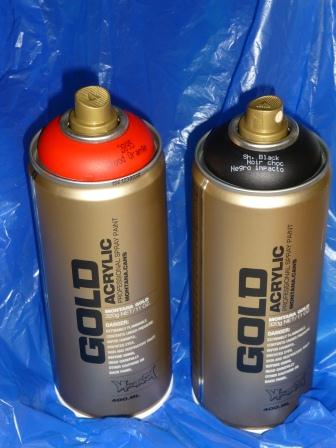
Chrome and Black is a supplier (I’d hesitate to call it a shop) dedicated to graffiti and street art. It reminded me vaguely of one of those old Swedish government owned liquor stores or the hardware shop in the famous Two Ronnies’ Four Candles sketch, as all the merchandise was locked away behind metal screens or glass cases — and the spraycans and markers came in a bewildering variety of colours. It’s not the sort of place where customers go to casually browse.
Dressed for work and carrying my Evening Standard, there was no way I was going to pretend I was some kind of cool graffiti artist (although from what I overheard I think there may have been a genuine street artist ‘name’ in the place at the time). So I asked the bloke behind the counter for something I could play around and experiment with. He recommended me the Montana Gold range and I took a red and black can of each (they were about £3.99 each, by the way).
Having a couple of cans of graffiti paint stuffed in my work rucksack made the journey back on Chiltern Railways feel faintly subversive. I’d guess a fair number of my fellow passengers would like to bring back hanging for anyone caught in possession of spraycans.
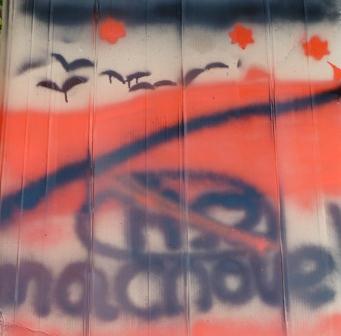
I had the cans but where the hell was I going to use them? Even if I was inclined to do my experimentation in public places there are hardly the post-industrial walls of Brick Lane near where I live. The most readily available blank canvasses would probably be sheep in the fields.
But I remembered the materials used by Adam Neate when he was unknown — he’s now one of the world’s most famous street artists. (The story goes, which is a little romanticised, that he literally left his works in the street for anyone to keep who found them.)
Neate painted his early work — and still sometimes does — on cardboard. He’s now an exceptionally collectible artist which is ironic as the base material for his work is potentially the potentially the contents of a typical recycling bin (he got his cardboard from charity shops I believe). His spray painting has an effect almost like alchemy on this otherwise base material, transforming it into something that art collectors will pay tens of thousands of pounds for.
Having a backlog of cardboard waiting to go to the tip, I decided to use it as my artist’s medium – as it happens, mainly packaging from a John Lewis fold-up bed. But I didn’t want to be ‘just’ an aerosol artist. I wanted to have a go at stencilling too. So I found what I thought was suitable — a thin piece of Amazon card packaging — and cut out a few shapes  with a Stanley knife.
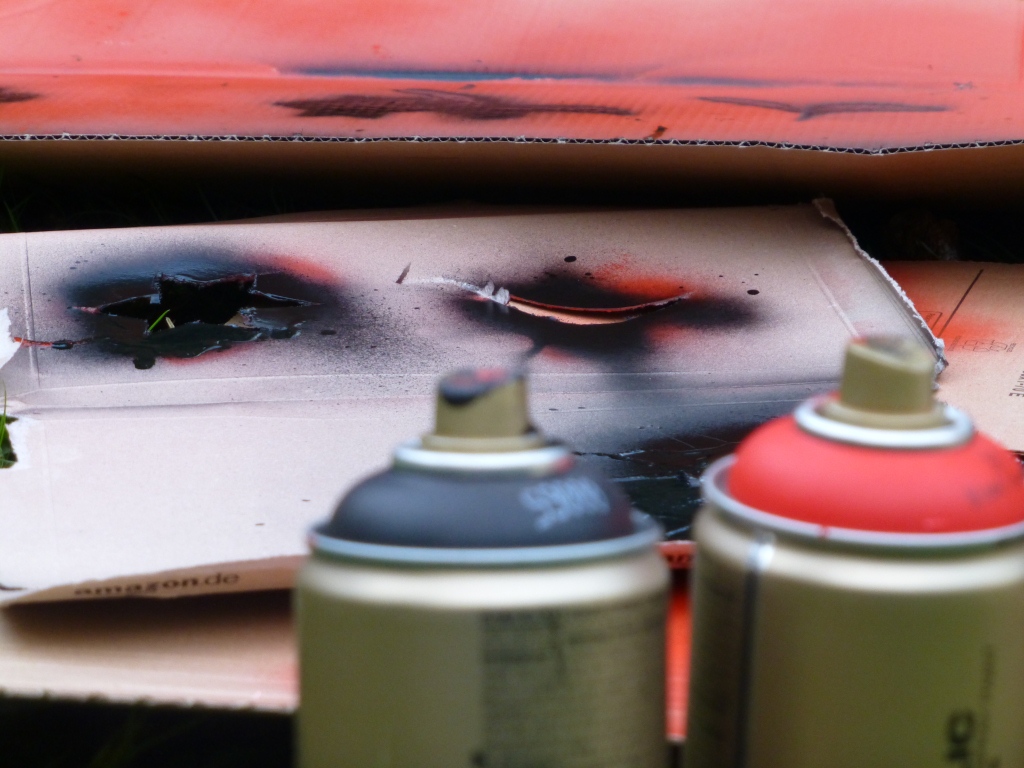
I went out into the garden with a willing helper, my spraycans, stencils and cardboard and had a go. And some of my efforts can be seen in the photos here.
Any thoughts on the artwork? I’m actually quite attached to it. I thought I’d throw it away instantly but I’ve hung on to it as I quite like it. Anyone who reads my manuscript will be able to spot exactly which part of the novel I was writing at the time by the stencilling I’ve attempted to do in the picture below.
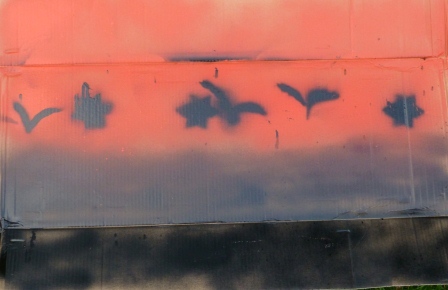
Clearly they’re just practice efforts but I really enjoyed it –and it was valuable for the writing. There are aspects of the experience that can’t be imagined that easily — or gleaned from a Google search — like the way it’s easy to over-apply the paint so that it starts to dribble and the way the paint coats your fingers. And then there’s the smell — it reeks of solvent. My novel’s graffiti painting scene takes place in an enclosed space and there’s no way that, having had a go at this myself, I could write the piece in the novel without mentioning the smell.
Becoming a temporary street artist might be the most extreme example of how I may have become a ‘method writer’. I don’t know whether there is such a thing but, if there is, I’d imagine it to be a little like the method school of acting which, to simplify greatly, means the actor prepares for the performance by trying to experience the world of the character.
According to the Lee Strasberg Institute website (he’s credited with inventing the technique) it uses ‘the creative play of the affective memory in the actor’s imagination’ to  ‘[create] performances grounded in the human truth of the moment’ — which I take to mean the actor tries to do the same stuff as the character — so these may be drawn upon in performance. So if the character is a dustman, perhaps the actor goes out on a dustcart a few mornings. I’m not sure how it works if a character is something like a serial killer, though.
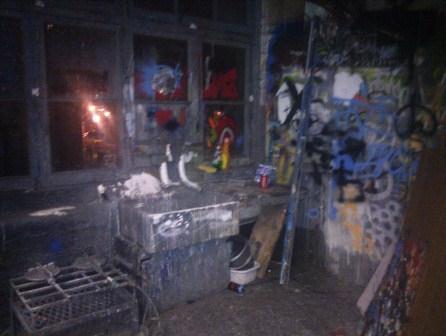
Even so, method acting reinforces Aristotle’s belief that ‘the secret to moving the passions in others is to be moved oneself’ — and this must also be true with writing. If the writer doesn’t care about a character, why should the reader? If the writer wants a scene to evoke emotions that create physical reactions in the reader, maybe of danger, peril, grief, anticipation or anger in the reader, then these ought to be more vivid or genuine if the writer also experienced these feelings at the time of putting the words on the page.
The same must also be true for the physical reactions triggered by effective sex scenes. If you’re writing about two characters who are so attracted to each other then it must be a mark of effective writing to engender a sympathetic reaction in the reader — which is probably why they’re so difficult to write that many writers avoid them altogether. Â And if they’re difficult to write then it’s a step further to workshop the stuff with your writing course friends, although that’s a pretty good deterrent against going too far along the path of purple prose.
I suspect most of the candidates for the Literary Review’s Bad Sex Awards, due to be announced fairly soon, ended up on the list by obfuscating the fundamental, but discomforting, truths of writing about sex behind over-elaborate prose or strained metaphors.
My MMU Creative Writing tutor last year had the good grace to admit to our class that he won this dubious prize for a passage in novel of his in the 1990s, which used a sewing machine analogy. I have actually read the passage in question and I don’t think it’s particularly cringeworthy, more taken out of context. He must have been unlucky — or lucky, if you think that sort of publicity is the good sort.
Sadly, my method writing hasn’t involved sex and sewing machines but the experience of writing the novel has influenced my life in plenty of other ways. Ironically I’m finding the normal advice of ‘write what you know’ could be better phrased in my case, as ‘know what you write’.
The novel’s themes include business, food and pubs (of which I have a fair amount of practical experience, particularly of the latter) and also art, which is something I’ve learned a lot about while writing the novel. As well as a number of viewings I’ve been to with I Know What I Like, I’ve also taken advantage of working in London to visit many of the high profile art exhibitions and events this summer.
Most recently, I’ve been to see the Turner Prize show and the Pre-Raphaelites at Tate Britain, Richard Hamilton and the Titian exhibition at the National, British Design at the V&A, the Bauhaus Exhibition (and another I can’t remember) at the Barbican, Damien Hirst at the Tate Modern, the Invisible Art show at the Hayward Gallery, the Lazaridis Bedlam exhibition at the Old Vic Tunnels (used as MI6’s bunker in Skyfall), the Moniker Art Fair at Village Underground and various others.
I doubt I’d have gone to a single event had I not started writing the novel — although going to so many events reduces the time I have available to complete the novel. I sometimes beat myself up about this but, on the other hand, I started writing the novel when working in the cultural wasteland that was an office park on the wrong side of Luton Airport, where the most exciting way of spending a lunchtime was to browse the aisles of the local Asda (although it’s an ambition of mine to write a novel that’s successful and mainstream enough to be put on the shelves there).
But binging on art and cultural events begs the fascinating question of which came first — did I start to write a novel about an artist because I wanted to discover more about art — or is it purely secondary?
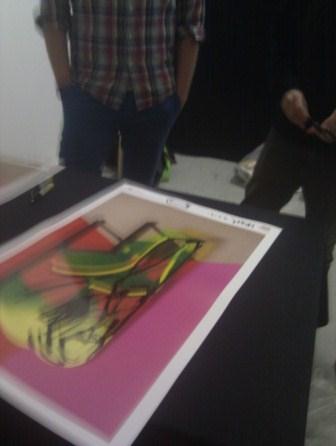
And then there’s the access I’ve had to artists via the brilliant Love Art London — about whom I’ve blogged before. How did I know that Adam Neate painted on cardboard? Because I heard him tell me himself at the Love Art London viewing of his show at Elms Lester’s Painting Rooms in St. Giles. I asked the gallery owner how much Adam Neate’s work was priced (as there were no figures on display next to the works on display). I was told they were in the region of £25-30k per piece (and one of his works was recently sold for £80k at auction). The bloke seriously thought I might buy one. Well, maybe, but probably only if this novel gets to the top of the Sunday Times bestseller list one day.
When the artist is able to sell work to serious collectors for so much money, it’s great credit to both Adam Neate and Love Art London that he attended our viewing to talk about the work — and even more impressive that he came to the pub with us afterwards — the appropriately named Angel.
Adam Neate was an incredibly nice, modest bloke — and I know because I ended up chatting to him for about fifteen minutes — even bought him a pint of Sam Smith’s. We talked about Berlin, as he was going there the next day for a weekend break. I told him a bit about the novel — as Berlin is where Kim was trained in the novel — and I’d guess that Berlin and London are the two main centres of urban art, certainly in Europe.
Not a bad journey in terms of method writing — starting by conceiving a character who’s a street artist, then trying to have a practical go at what she does and then talking about the fictional character with someone who’s achieved in reality what my character is striving for in the novel.
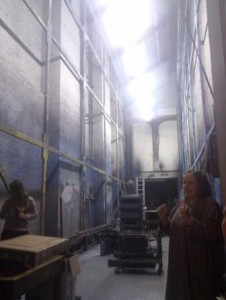
I could have spent the time revising the novel rather than going out and validating my portrayal of the artist. Instead I might have a finished novel by now but would it be genuine and informed enough to move readers, particularly those who are interested in art?
It’s worth making a note about the fascinating space at Elms Lesters. The gallery was originally built for huge scale painting for West End theatres. It still has an incredible space about forty feet high and much less wide that was constructed for painting theatrical backdrops — and is now used for filming things like music videos as much as for anything else. It’s quite an extraordinary building.

2 Replies to “Know What You Write”